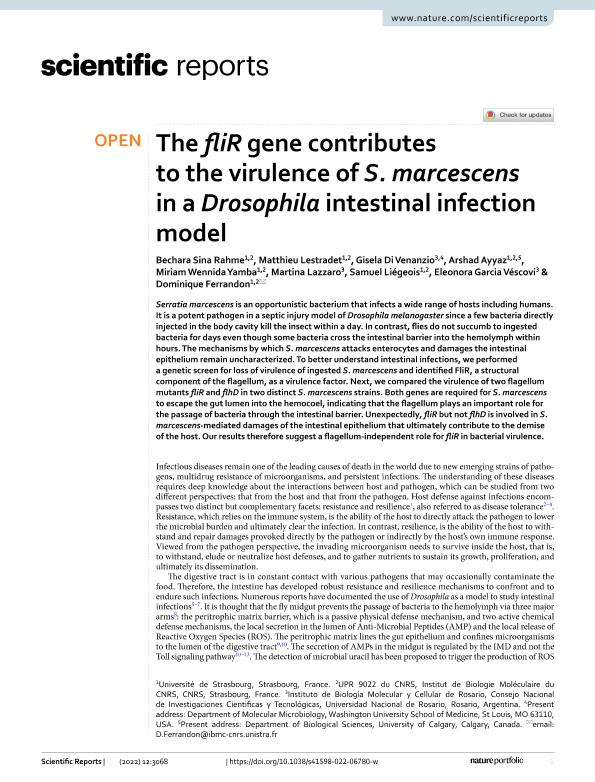Mostrar el registro sencillo del ítem
dc.contributor.author
Sina Rahme, Bechara
dc.contributor.author
Lestradet, Matthieu
dc.contributor.author
Di Venanzio, Gisela Andrea

dc.contributor.author
Ayyaz, Arshad
dc.contributor.author
Wennida Yamba, Miriam
dc.contributor.author
Lazzaro, Martina

dc.contributor.author
Liégeois, Samuel
dc.contributor.author
Garcia Vescovi, Eleonora

dc.contributor.author
Ferrandon, Dominique
dc.date.available
2023-10-02T12:46:46Z
dc.date.issued
2022-02
dc.identifier.citation
Sina Rahme, Bechara; Lestradet, Matthieu; Di Venanzio, Gisela Andrea; Ayyaz, Arshad; Wennida Yamba, Miriam; et al.; The fliR gene contributes to the virulence of S. marcescens in a Drosophila intestinal infection model; Nature; Scientific Reports; 12; 1; 2-2022; 1-10
dc.identifier.issn
2045-2322
dc.identifier.uri
http://hdl.handle.net/11336/213723
dc.description.abstract
Serratia marcescens is an opportunistic bacterium that infects a wide range of hosts including humans. It is a potent pathogen in a septic injury model of Drosophila melanogaster since a few bacteria directly injected in the body cavity kill the insect within a day. In contrast, flies do not succumb to ingested bacteria for days even though some bacteria cross the intestinal barrier into the hemolymph within hours. The mechanisms by which S. marcescens attacks enterocytes and damages the intestinal epithelium remain uncharacterized. To better understand intestinal infections, we performed a genetic screen for loss of virulence of ingested S. marcescens and identified FliR, a structural component of the flagellum, as a virulence factor. Next, we compared the virulence of two flagellum mutants fliR and flhD in two distinct S. marcescens strains. Both genes are required for S. marcescens to escape the gut lumen into the hemocoel, indicating that the flagellum plays an important role for the passage of bacteria through the intestinal barrier. Unexpectedly, fliR but not flhD is involved in S. marcescens-mediated damages of the intestinal epithelium that ultimately contribute to the demise of the host. Our results therefore suggest a flagellum-independent role for fliR in bacterial virulence.
dc.format
application/pdf
dc.language.iso
eng
dc.publisher
Nature

dc.rights
info:eu-repo/semantics/openAccess
dc.rights.uri
https://creativecommons.org/licenses/by/2.5/ar/
dc.subject
Serratia
dc.subject
FliR
dc.subject
Drosophila
dc.subject
virulence
dc.subject.classification
Biología Celular, Microbiología

dc.subject.classification
Ciencias Biológicas

dc.subject.classification
CIENCIAS NATURALES Y EXACTAS

dc.title
The fliR gene contributes to the virulence of S. marcescens in a Drosophila intestinal infection model
dc.type
info:eu-repo/semantics/article
dc.type
info:ar-repo/semantics/artículo
dc.type
info:eu-repo/semantics/publishedVersion
dc.date.updated
2023-07-07T20:18:25Z
dc.journal.volume
12
dc.journal.number
1
dc.journal.pagination
1-10
dc.journal.pais
Reino Unido

dc.description.fil
Fil: Sina Rahme, Bechara. Centre National de la Recherche Scientifique; Francia
dc.description.fil
Fil: Lestradet, Matthieu. Centre National de la Recherche Scientifique; Francia
dc.description.fil
Fil: Di Venanzio, Gisela Andrea. Consejo Nacional de Investigaciones Científicas y Técnicas. Centro Científico Tecnológico Conicet - Rosario. Instituto de Biología Molecular y Celular de Rosario. Universidad Nacional de Rosario. Facultad de Ciencias Bioquímicas y Farmacéuticas. Instituto de Biología Molecular y Celular de Rosario; Argentina
dc.description.fil
Fil: Ayyaz, Arshad. Centre National de la Recherche Scientifique; Francia
dc.description.fil
Fil: Wennida Yamba, Miriam. Centre National de la Recherche Scientifique; Francia
dc.description.fil
Fil: Lazzaro, Martina. Consejo Nacional de Investigaciones Científicas y Técnicas. Centro Científico Tecnológico Conicet - Rosario. Instituto de Biología Molecular y Celular de Rosario. Universidad Nacional de Rosario. Facultad de Ciencias Bioquímicas y Farmacéuticas. Instituto de Biología Molecular y Celular de Rosario; Argentina
dc.description.fil
Fil: Liégeois, Samuel. Centre National de la Recherche Scientifique; Francia
dc.description.fil
Fil: Garcia Vescovi, Eleonora. Consejo Nacional de Investigaciones Científicas y Técnicas. Centro Científico Tecnológico Conicet - Rosario. Instituto de Biología Molecular y Celular de Rosario. Universidad Nacional de Rosario. Facultad de Ciencias Bioquímicas y Farmacéuticas. Instituto de Biología Molecular y Celular de Rosario; Argentina
dc.description.fil
Fil: Ferrandon, Dominique. Centre National de la Recherche Scientifique; Francia
dc.journal.title
Scientific Reports
dc.relation.alternativeid
info:eu-repo/semantics/altIdentifier/doi/https://doi.org/10.1038/s41598-022-06780-w
Archivos asociados
